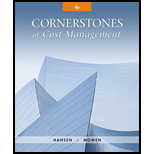
Lander Parts, Inc., produces various automobile parts. In one plant, Lander has a manufacturing cell with the theoretical capability to produce 450,000 fuel pumps per quarter. The conversion cost per quarter is $9,000,000. There are 150,000 production hours available within the cell per quarter.
Required:
- 1. Compute the theoretical velocity (per hour) and the theoretical cycle time (minutes per unit produced).
- 2. Compute the ideal amount of conversion cost that will be assigned per subassembly.
- 3. Suppose the actual time required to produce a fuel pump is 40 minutes. Compute the amount of conversion cost actually assigned to each unit produced. What happens to product cost if the time to produce a unit is decreased to 25 minutes? How can a firm encourage managers to reduce cycle time? Finally, discuss how this approach to assigning conversion cost can improve delivery time.
- 4. Assuming the actual time to produce one fuel pump is 40 minutes, calculate MCE. How much non-value-added time is being used? How much is it costing per unit?
- 5. Cycle time, velocity, MCE, conversion cost per unit (theoretical conversion rate × actual conversion time), and non-value-added costs are all measures of performance for the cell process. Discuss the incentives provided by these measures.
1.
Calculate the theoretical velocity and the theoretical cycle time.
Explanation of Solution
Cycle time: Cycle time and velocity are two operational “measures of responsiveness”. Cycle time is the span of time taken to produce a unit of output from the time the materials are received till the good is supplied to finished goods inventory. Therefore, cycle time is the time taken to produce a product.
Velocity: Velocity is the number of units of output that could be produced within a given period of time.
Calculate theoretical velocity:
Calculate theoretical cycle time:
2.
Calculate ideal amount of conversion cost assigned per subassembly.
Explanation of Solution
Conversion cost: The cost of changing the materials into a finished product. It includes direct labour costs and manufacturing overhead costs.
Calculate the conversion cost assigned per subassembly:
Working note:
(1)Calculate the conversion cost rate:
3.
Explain the manner in which this approach in assigning conversion cost can improve delivery time.
Explanation of Solution
The conversion cost assigned will be $25
Working note:
(2)Calculate applied conversion cost:
4.
Calculate MCE (manufacturing cycle efficiency), the non-value –added time used and calculate the costing per unit.
Explanation of Solution
Calculate manufacturing cycle efficiency:
Calculate wasted time:
Calculate the costing per unit:
5.
Briefly discuss the incentives provided by these measures.
Explanation of Solution
- Organizations must compete depending upon the time and cost in the advanced “manufacturing environment” and these objectives are supported by these measures. The aim is to reduce the cycle time by evading non-value added time.
- Since non-value-added time is decreased, manufacturing cycle efficiency is increased, and the conversion cost allocated per unit reduces. Likewise, as manufacturing cycle efficiency increases, a non-value-added time declines and non-value-added costs decrease, resulting in a lower-cost product.
Want to see more full solutions like this?
Chapter 13 Solutions
Cornerstones of Cost Management (Cornerstones Series)
- Accurate answerarrow_forwardCan you please solve this problem with correct answer?arrow_forwardSwiftTech Inc.'s stock is currently selling for $95.20 pershare at year-end. This year, the company paid shareholders a $7.50 per share. cash dividend. It also reported earnings per share of $12.40 and had 820,000common shares outstanding at year-end. Calculate the company's dividend yield.arrow_forward
- Mona Manufacturing applies manufacturing overhead to its cost objects on the basis of 65% of direct material cost. If Job 24B had $84,500 of manufacturing overhead applied to it during June, the direct materials assigned to Job 24B was:arrow_forwardsubject : General accounting questionarrow_forwardNeed answerarrow_forward
- Compute operating leveragearrow_forwardPayroll Register and Payroll Journal Entry Mary Losch operates a travel agency called Mary's Luxury Travel. She has five employees, all of whom are paid on a weekly basis. The travel agency uses a payroll register, individual employee earnings records, and a general journal. Mary's Luxury Travel uses a weekly federal income tax withholding table. Refer to Figure 8-4 in the text. The payroll data for each employee for the week ended March 22, 20-, are shown. Employees are paid 12 times the regular rate for working over 40 hours a week. Name No. of Marital Allowances Status Total Hours Worked Mar. 16- Rate 22 Total Earnings Jan. 1- Mar. 15 Bacon, 4 M 46 $12.00 $5,480.00 Andrea Cole, 1 S 40 12.00 5,840.00 Andrew Hicks, 3 M 45 10.50 4,800.00 Melvin Leung, 1 S 37 11.00 5,113.00 Cara Melling, Melissa 2 M 40 13.00 4,742.00 Social Security tax is withheld from the first $128,400 of earnings at the rate of 6.2%. Medicare tax is withheld at the rate of 1.45%, and city earnings tax at the rate of…arrow_forwardAccurate Answerarrow_forward
 Cornerstones of Cost Management (Cornerstones Ser...AccountingISBN:9781305970663Author:Don R. Hansen, Maryanne M. MowenPublisher:Cengage Learning
Cornerstones of Cost Management (Cornerstones Ser...AccountingISBN:9781305970663Author:Don R. Hansen, Maryanne M. MowenPublisher:Cengage Learning
